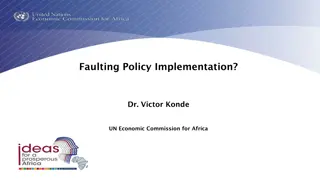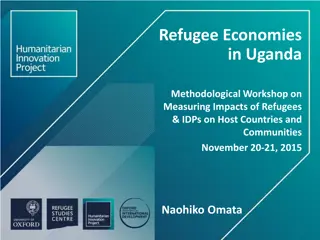Policy Implementation in Uganda: Evidence and Challenges
This research delves into the implementation of policies in Uganda with a focus on insights from previous Economic Growth Forum (EGF) recommendations. Analysts like Milly Kaddu and Ramathan Ggoobi highlight the importance of a dedicated policy on implementation. Methods for assessing policy progress include tracking indicators, interviews, and scale assessments. Examples and metrics are provided to showcase the process. Sectors such as public investment, agriculture, and trade are evaluated for progress. The study underscores the need for effective policy implementation mechanisms in Uganda.
Download Presentation

Please find below an Image/Link to download the presentation.
The content on the website is provided AS IS for your information and personal use only. It may not be sold, licensed, or shared on other websites without obtaining consent from the author.If you encounter any issues during the download, it is possible that the publisher has removed the file from their server.
You are allowed to download the files provided on this website for personal or commercial use, subject to the condition that they are used lawfully. All files are the property of their respective owners.
The content on the website is provided AS IS for your information and personal use only. It may not be sold, licensed, or shared on other websites without obtaining consent from the author.
E N D
Presentation Transcript
13 January 2022 Policy implementation in Uganda Evidence from previous EGF recommendations Milly Kaddu, Economic Policy Analyst
Outline Background / problem Methods Preliminary results Key challenges Conclusion 2
I have always said that this country has designed many good policies but one that is missing is a policy on implementation Ramathan Ggoobi, PS/ST
How to assess policy implementation? Our process Source material official documents 1. Identify recommendations from previous EGF events, and design process indicators 2. Track progress of indicators through official government documents 3. Interview officials and external experts to verify this information 4. Assess progress on indicator on a 1-5 scale Ministerial Policy Statements Budget framework papers Annual Budget Performance Reports OPM Government Annual Performance Report 4
Example policy agreed at EGFs I, III, & IV Fast-track Public Investment Management (PIM) Reforms, to streamline coordination within implementing MDAs and between technical and political leadership, by institutionalizing joint selection, appraisal, planning & monitoring for related projects. As part of this: a) Streamline project selection, preparation and appraisal before projects are approved for financing b) Strengthen institutional arrangements for projects appraisal and monitoring c) Build capacity for project appraisal to improve on the quality of projects 6
Metrics we coded Task characteristics Implementation status where the policy is up to? Recurrence How frequently does the task occur? Complexity Does the task require specialist skills? Challenges to implementation what are the main obstacles to progress? Coordination Which stakeholders are required to achieve the task? Scope How narrowly is the task defined? 7
How much progress have different sectors made in implementing policies agreed at the EGF? Scored on a 1-5 scale Average assessment across all policies in each thematic area Assessment based on official documents and interviews with civil servants and external experts Public investment Agriculture Trade 1 2 3 4 5 Average progress assessment 8
Trade average performance 3.5/5 Coordination required? Same MDA Other MDAs External Specialist knowledge required Technical complexity Simple Task scope One step One task Recurrence Repeated One-off Continuous 9
Key challenges to implementation? Coordination Coordinating multiple stakeholders, inside and outside government is expensive, both in terms of time and budget E.g. Review of EAC-CET (EGF III) coordination across countries highly complex Overlapping mandates Can lead to a situation where no single actor is accountable for outputs, making it challenging to get things done E.g. Special Economic Zones shared responsibility between UIA, UNBS, MTIC and UEPB Financing Lack of funding a common problem due to limited fiscal space but this reflects government s own prioritisation E.g. NTBs reporting system has been down since TMEA stopped paying for subscription 10
Conclusion There is quite a number of shortfalls to policy implementation in Uganda, evidenced by non implementation of some policies. This study takes a case of EGFs policy implementation. The presentation has preliminary findings on evaluation of policy implementation in Uganda, using mixed methods. A detailed report will be availed very soon and findings will be disseminated to MDAs, with suggested remedies. 11
Thank you 12























